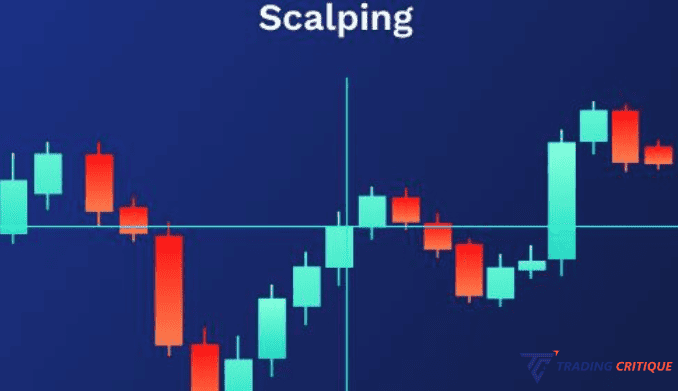Scalping Traders
Scalping, as a Trading strategy, revolves around capitalizing on minor price fluctuations within a stock’s value. Traders who employ this technique, known as scalpers, engage in a high frequency of trades throughout a single trading day. Their underlying belief is that it’s easier to capture small price movements compared to substantial ones. By implementing a strict exit strategy to mitigate potential losses, these traders aim to accumulate numerous small profits, ultimately translating into significant gains. Scalping involves profiting from small price changes in a short timeframe, often within a day.
Traders buy or sell at bid/ask prices and quickly resell for a small profit, typically holding for seconds to minutes. Scalpers employ various strategies, such as buying low and selling high, or shorting high and covering low, and they often use Level 2 data and time of sales for rapid execution. Common mistakes in Scalping include execution errors, neglecting Stop-loss orders, over-leveraging, entering or exiting trades too late, and excessive trading. Frequent trades can result in substantial commissions, making per-share pricing advantageous for scalpers.
How Does it Work
Scalping Trading means buying and selling stocks or currencies quickly to make small profits. Traders only hold onto their investments for a short time, like a few seconds or minutes, and then sell them. They buy when prices are low and sell when they go up a bit, even if it’s just a small increase.
Scalpers do this because they want to make money when the market is good and avoid losing money when it’s not. Some people think scalpers make less money, but because they do lots of quick trades, they have a better chance of making a profit.
Regular traders try to make big profits with fewer trades. Scalpers focus on making lots of small profits with many trades. They believe it’s less risky to bet on small price changes than big ones.
Scalpers are different from regular traders because they buy and sell many times a day based on what’s happening in the market. They set strict rules for when to buy and sell, based on how much prices change and how much time they hold onto their investments. And unlike regular traders who hold onto stocks that are going up, scalpers sell them right away, no matter what.
Crucial Factors to Consider Before Scalping
Strategies for Effectively Implementing Scalping Techniques
Scalping is a high-speed trading approach that requires precision and rapid decision-making. This guide explores effective strategies to simplify market movements, improve Entry and exit points, and enhance your success in Scalping. Let’s immerse ourselves and become proficient in the skill of profitable Scalping.
- Profit from Multiple Trades: Scalping enables traders to accumulate profits from numerous trades within a single trading day, as opposed to relying on a few significant trades.
- Risk Management: Due to the substantial leverage involved in Scalping, it is inherently risky. Novice scalpers must prioritize risk management in their strategy to mitigate potential losses.
- Exit Strategy: A robust exit strategy is essential to prevent losses. Staying in trade as prices decline can lead to significant losses, so knowing when to exit is crucial.
- Key Attributes: Successful scalpers should possess qualities like focus, dedication, discipline, alertness, speed, and decisiveness. These traits are vital for capitalizing on small fluctuations in stock prices.
- Timely Actions: Missing unfavorable price movements can result in avoidable losses. Scalpers should act swiftly to enter and exit trades in response to market conditions.
- Minimal Loss Exit: Traders should have a clear plan for exiting a trade with minimal losses to protect their capital in the face of stock price fluctuations.
- Target-Based Exits: Instead of waiting for more profit or hoping for a rebound, scalpers should exit trades when they reach predefined profit or loss levels.
- Stock Selection: Focus on trading highly liquid and volatile stocks, as they allow for rapid entry and exit, a key advantage for scalpers.
- Market Analysis: In addition to monitoring news and market trends, scalpers should use technical momentum indicators like Moving Average Convergence Divergence (MACD), candlestick charts, pivot points, and the Relative Strength Index (RSI) to assess market conditions before initiating trades.
- Predictive Tools: Utilize technical indicators to predict price movements and make informed trading decisions. These tools enhance a scalper’s ability to identify potential opportunities and manage risk effectively.
Scalping vs. Day Trading vs. Swing Trading
In the financial markets, there are different trading strategies like Scalping, Day trading, and swing trading. These methods have unique features and are important for traders, especially beginners, to understand. This discussion will highlight the key differences between these strategies, including how long you hold assets, how often you trade, your profit goals, and who each strategy is suitable for. Knowing these distinctions is crucial for traders navigating the world of trading.
| Parameters | Scalping | Day Trading | Swing Trading |
|---|---|---|---|
| Basics | Day trading employing Scalping tactics | May include or exclude Scalping tactics | Not defined by any particular characteristic |
| Holding Period | Seconds, minutes, or hours in a day | Until the market closes on the same day | Days, weeks, and even months |
| Trade Frequency | Multiple trades in a day | Several trades throughout a day | Multiple trades in a week |
| Profit Targets | Small but multiple profits | Small but multiple profits | A few large profits |
| Trader Level | Not recommended for amateurs | Suitable for both experienced and novice traders | Suitable for all types of traders |
| Monitoring Requirement | Regular monitoring required | Monitoring at regular intervals recommended | Reasonable monitoring expected |
Example of Scalping Trading
Guidance for Beginner Scalpers
- Choose a trading style that aligns with your personality since Scalping requires a disciplined approach, quick decision-making, and constant screen monitoring. It’s ideal for those who find satisfaction in small successful trades.
- Recognize that Scalping demands fast decision-making, continuous position monitoring, and frequent trade execution, making it less suitable for beginners.
- Focus on efficient order execution to avoid costly mistakes, as delays or incorrect orders can erase profits or even lead to losses. Utilize support systems like Direct Access Trading and Level 2 quotations.
- Be mindful of costs due to the high frequency of Scalping trades, which can result in substantial commissions. Choose an online broker with competitive commissions and ensure they allow Scalping.
- Develop the skill to spot market trends and momentum, as this knowledge can help you enter and exit trades strategically to replicate patterns for profits. Stick to trading with the trend as a novice and avoid countertrend strategies.
- Start by trading on the buy-side as a beginner and gain confidence before venturing into short-side trading. Balancing long and short trades is essential for long-term success in Scalping.
- Equip yourself with basic technical analysis skills to compete effectively in the Intraday trading world, especially in markets dominated by High-frequency trading and dark pool trading that lacks real-time reporting.
- Use technical indicators designed for very short time frames, such as the moving average ribbon entry strategy, the relative strength/weakness exit strategy, and multiple chart Scalping, to identify short-term opportunities.
- Implement the multiple charts Scalping strategy, including a 15-minute chart without indicators to track background conditions and lines for opening print, high, and low of the trading range. Look for Price action at these levels, aligning with support and resistance levels on larger-scale charts.
- Pay attention to liquidity levels, as Scalping relies on frequent entry and exit decisions. High-volume trades provide the necessary liquidity for successful Scalping.
- Maintain discipline by closing all positions within the same trading session. Scalping relies on seizing small market opportunities and holding positions for a short time is fundamental to this strategy.
Factors that Impact Scalping
Scalping is about seizing fast market opportunities for small profits. To excel, traders must consider factors like market liquidity, price stability, trading speed, and risk management. This guide explores how these factors impact Scalping strategies for profit.
Advantages and Disadvantages of Scalping Trading
 Pros of Scalping Trading Pros of Scalping Trading |  Cons of Scalping Trading Cons of Scalping Trading |
|---|---|
| Immediate exit strategy provides numerous benefitsFocuses on Short-term trading, minimizing reliance on fundamentalsLow risk with proper stop-loss placementCapitalizes on small price fluctuations independently of overall trends | Requires a significant amount of trading experienceHandling multiple trades simultaneously can be confusingLimited profit per trade necessitates frequent tradingPotential for overtrading due to the need for numerous trades |
In a Nutshell
Explore our trading review website to find detailed reviews on trading, forex, CFDs, stocks, and cryptocurrencies. Stay up-to-date with the latest trends and advancements in the trading and investment world by reading our informative blogs. Start your journey today to enhance your knowledge and gain valuable insights from our Trading Critique platform.
Frequently Asked Questions
1. Who is Scalper?
A scalper is an individual or trader who engages in a specific style of trading characterized by rapid buying and selling of financial instruments or other goods to profit from small price movements or price discrepancies. Scalping is a Short-term Trading strategy where the trader aims to make quick, often small, profits by taking advantage of minor fluctuations in prices.
2. Is Scalping a Wise Choice for Novice Traders?
No, Scalping is not advisable for beginners. This approach involves rapid decision-making, and profits or losses can occur within seconds or minutes. Scalpers need to be highly experienced, possess extensive market knowledge, and remain vigilant throughout the trade, making it unsuitable for newcomers.
3. Is Scalping Trading Within Legal Bounds?
Scalping Trading is typically legal, although its permissibility may vary among different brokers. Some brokers might restrict Scalping due to the high number of trades involved. Nonetheless, in most instances, Scalping is considered both safe and legal within the stock market. In the Indian context, Scalping is legal, with its historical context considered when assessing its acceptability. In the past, a large number of intraday transactions raised concerns about trading system disruption, but modern exchanges and brokers now support Scalping efficiently and securely.
4. Can You Make Profits in Scalping Trading?
Scalping Trading can be profitable, but it depends on the trader’s strategy, experience, and the number of trades they make in a day. In Scalping, you need a substantial amount of funds to profit from many small trades. More trades can mean more profit, but only if you’re highly skilled in short timeframes. While there’s a lower risk, having the right entry and exit strategies is crucial to avoid losses.






